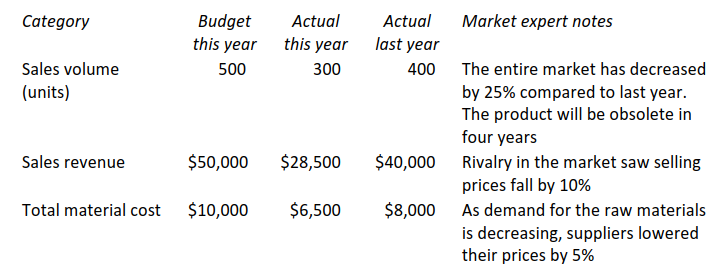快速查题-ACCA英国注册会计师试题
- 不限题型
- 不定项选择题
- 单选题
- 填空题
- 材料题
- 简答题
- 论述题
Using the information provided demonstrate how the planning and operational variances in the operating statement have been calculated.
Explain the significance of separating variances into planning and operational elements and the problems which could arise.
PlasBas Co uses recycled plastic to manufacture shopping baskets for local retailers. The standard price of the recycled plastic is $0.50 per kg and standard usage of recycled plastic is 0.2 kg for each basket. The budgeted production was 80,000 baskets.
Due to recent government incentives to encourage recycling, the standard price of recycled plastic was expected to reduce to $0.40 per kg. The actual price paid by the company was $0.42 per kg and 100,000 baskets were manufactured using 20,000 kg of recycled plastic.
What is the materials operational price variance?
A profit centre manager claims that the poor performance of her division is entirely due to factors outside her control. She has submitted the following table along with notes from a market expert, which she believes explains the cause of the poor performance:
 After adjusting for the external factors outside the manager’s control, in which category/categories is there evidence of poor performance?
After adjusting for the external factors outside the manager’s control, in which category/categories is there evidence of poor performance?
The following statements have been made about planning and operational variances:
(1) Planning and operational variances are calculated when it is necessary to assess a manager on results that are within his/her control.
(2) Revised standards are required because variances may arise partly due to an unrealistic budget, and not solely due to operational factors.
Which of the above statement(s) is/are true?
If a planning efficiency variance is valued at an original standard rate, the planning rate variance is valued at the original efficiency level.
A company sells a single product. Budgeted and actual sales data for the period just ended are as follows.

The budget was based on an expectation that the company would maintain its 20% share of the market. It was subsequently recognised that the actual market size, due to unforeseen changes in customer buying behaviour, was only 90,000 units. It was therefore decided to report sales volume variances as a market share variance and a market size variance.
What was the market share variance, and should this be controllable by operational sales managers?
This question appeared in the June 2015 exam.
Caf Co budgeted to sell 10,000 units of a new product in the period at a budgeted selling price of $5 per unit. Actual sales volumes in the period were as budgeted but the actual sales price achieved was only $4 per unit. This was because a competitor launched a similar product at the same time. Caf Co had been aware that this was going to happen when it prepared its budget and, had it known this, it would have revised its expected selling price to $3.80 per unit, which was the price of the competitor's product.
What is the sales price planning variance?
This question appeared in the June 2015 exam.
The following budgeted data for a particular period was available for a company selling two products:

The actual results for the period were as follows:

What is the sales quantity contribution variance?
Which of the following variances should a production manager be held responsible for?
